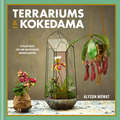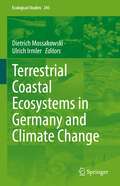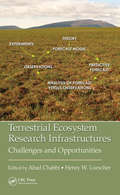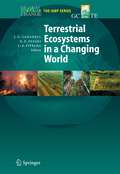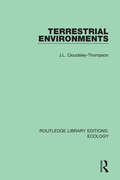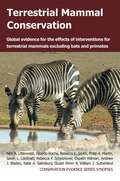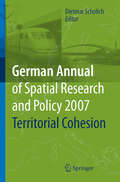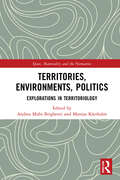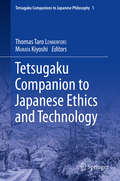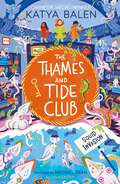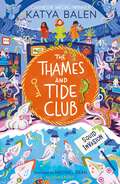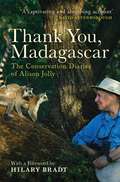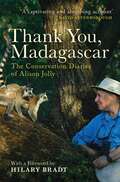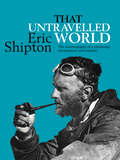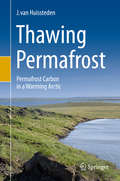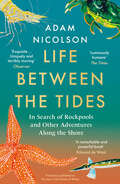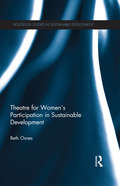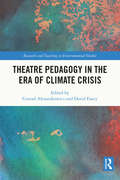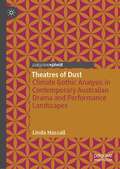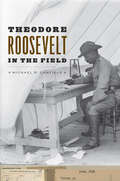- Table View
- List View
Terrariums & Kokedama
by Alyson MowatTerrariums, aeriums and kokedama (Japanese for 'moss ball') have exploded in popularity and making them at home is surprisingly easy and a wonderful way to keep plants in our homes. In this inspirational guide, Alyson Mowat shares her creative ideas for greening up your home and workspace, with 20 projects to make your own botanical beauties and containers to show them off. Alyson guides you through the information and tools you'll need to help cultivate your green thumb, before sharing her tips for making your own unique containers, such as a concrete planter or kokedama tray, choosing the best plants for your space and desired effort, and even includes tips to propagate them. With names such as Through the Looking Glass, Plant-O-Saurus and Hung Up on You, the projects are fun and quirky, bringing the outside in. With Alyson's keen, stylish eye, you can create chic, low-maintenance greenery to cover your home or work.
Terrestrial Coastal Ecosystems in Germany and Climate Change (Ecological Studies #245)
by Dietrich Mossakowski Ulrich IrmlerClimate change is one of the most severe dangers for mankind worldwide. Beside the temperature increase, the sea level will rise and flood wide coastal areas, which is already remarkable today. The effects will be dramatic, in particular, at coasts with low elevation gradients such as at the German coasts of the North and Baltic Sea. The impact will be not only severe for coastal people, but still more for the unique coastal ecosystems, which harbors many plant and animal species that are already endangered today.This book focuses on the coastal terrestrial ecosystems of the German North and Baltic Sea. It describes the reactions of plants and animals (i.e. spiders, carabid beetles, bees and nematodes) on the future temperature and sea level increase. The combination of field and experimental studies is unique for Europe and for many parts of the world. It not only studies the actual elevation gradients and the climatic and saline gradients from West to East, but also the historical changes to document processes at coastal ecosystems that were already passed. In contrast to many books that studied the marine processes with similar backgrounds, this book concerns the terrestrial coastal ecosystems that were overall rarely studied and, in particular, never studied under this specific viewpoint.
Terrestrial Ecosystem Research Infrastructures: Challenges and Opportunities
by Abad Chabbi Henry W. LoescherTerrestrial Ecosystem Research Infrastructures: Challenges and Opportunities reveals how environmental research infrastructures (RIs) provide new valuable insights on ecological processes that cannot be realized by more traditional short-term funding cycles and are integral to understand our changing world. This book bonds the latest state-of-the-science knowledge on environmental RIs, the challenges in creating them, their place in addressing scientific frontiers, and the new perspectives they bear. Each chapter is thoughtfully invested with fresh viewpoints from the environmental RI vantage as the authors explore and explain many topics such as the rationale and challenges in global change, field and modeling platforms, new tools, challenges in data management, distilling information into knowledge, and new developments in large-scale RIs. This work serves an advantageous guide for academics and practitioners alike who aim to deepen their knowledge in the field of science and project management, and logistics operations.
Terrestrial Ecosystems in a Changing World (Global Change - The IGBP Series)
by Josep G. Canadell Diane E. Pataki Louis F. PitelkaThis book examines the impacts of global change on terrestrial ecosystems. Emphasis is placed on impacts of atmospheric, climate and land use change, and the book discusses the future challenges and the scientific frameworks to address them. Finally, the book explores fundamental new research developments and the need for stronger integration of natural and human dimensions in addressing the challenge of global change.
Terrestrial Environments (Routledge Library Editions: Ecology #16)
by J.L. Cloudsley-ThompsonOriginally published in 1975 Terrestrial Environments covers the zoogeography and ecology of the main terrestrial environments of the world, including fresh water habitats with emphasis on their fauna. The book also explores climate and vegetation in so far as they affect animal life. Finally, the selective influence of the environment on its fauna is discussed and, conversely, the influence of regulation, a synthesis of these interrelations. Morphological adaptations of the animals inhabiting various types of terrestrial environments are considered in relation to locomotion, feeding, and escape from enemies. Physiological adaptations are also mentioned briefly, and the adaptative importunate of diurnal and seasonal rhythms is stressed.
Terrestrial Environments (Routledge Library Editions: Ecology #16)
by J.L. Cloudsley-ThompsonOriginally published in 1975 Terrestrial Environments covers the zoogeography and ecology of the main terrestrial environments of the world, including fresh water habitats with emphasis on their fauna. The book also explores climate and vegetation in so far as they affect animal life. Finally, the selective influence of the environment on its fauna is discussed and, conversely, the influence of regulation, a synthesis of these interrelations. Morphological adaptations of the animals inhabiting various types of terrestrial environments are considered in relation to locomotion, feeding, and escape from enemies. Physiological adaptations are also mentioned briefly, and the adaptative importunate of diurnal and seasonal rhythms is stressed.
Terrestrial Mammal Conservation: Global Evidence for the Effects of Interventions for Terrestrial Mammals Excluding Bats and Primates
by Nick A. Littlewood Ricardo Rocha Rebecca K. Smith Philip A. Martin Sarah L. Lockhart Rebecca F. SchoonoverTerrestrial Mammal Conservation provides a thorough summary of the available scientific evidence of what is known, or not known, about the effectiveness of all of the conservation actions for wild terrestrial mammals across the world (excluding bats and primates, which are covered in separate synopses). Actions are organized into categories based on the International Union for Conservation of Nature classifications of direct threats and conservation actions. Over the course of fifteen chapters, the authors consider interventions as wide ranging as creating uncultivated margins around fields, prescribed burning, setting hunting quotas and removing non-native mammals. This book is written in an accessible style and is designed to be an invaluable resource for anyone concerned with the practical conservation of terrestrial mammals. The authors consulted an international group of terrestrial mammal experts and conservationists to produce this synopsis. Funding was provided by the MAVA Foundation, Arcadia and National Geographic Big Cats Initiative. Terrestrial Mammal Conservation is the seventeenth publication in the Conservation Evidence Series, linked to the online resource www.ConservationEvidence.com. Conservation Evidence Synopses are designed to promote a more evidence-based approach to biodiversity conservation. Others in the series include Bat Conservation, Primate Conservation, Bird Conservation and Forest Conservation and more are in preparation. Expert assessment of the evidence summarised within synopses is provided online and within the annual publication What Works in Conservation.
Territorial Cohesion (German Annual of Spatial Research and Policy)
by Dietmar Scholich"Territorial cohesion" strives for a more balanced spatial development and seeks to improve integration throughout the EU. The scientific articles in this volume examine the interpretations of this term, the challenges of European spatial development policy, and the problems and concepts involved in achieving territorial cohesion. Two short reports illustrate the implementation of territorial cohesion on the basis of two research projects.
Territories, Environments, Politics: Explorations in Territoriology
by Andrea Mubi BrighentiThis collection seeks to illustrate the state of the art in territoriological research, both empirical and theoretical. The volume gathers together a series of original, previously unpublished essays exploring the newly emerging territorial formations in culture, politics and society. While the globalisation debate of the 1990s largely pivoted around a ‘general deterritorialisation’ hypothesis, since the 2000s it has become apparent that, rather than effacing territories, global connections are added to them, and represent a further factor in the increase of territorial complexity. Key questions follow, such as: How can we further the knowledge around territorial complexities and the ways in which different processes of territorialisation co-exist and interact, integrating scientific advances from a plurality of disciplines? Where and what forms does territorial complexity assume, and how do complex territories operate in specific instances? Which technological, political and cultural facets of territories should be tackled to make sense of the life of territories? How and by what different or combined methods can we describe territories, and do justice to their articulations and meanings? How can the territoriological vocabulary relate to contemporary social theory advancements such as ANT, the ontological turn, the mobilities paradigm, sensory urbanism, and atmospheres research? How can territorial phenomena be studied across disciplinary boundaries? Territories, Environments, Politics casts a fresh perspective onto a number of key contemporary socio-spatial phenomena. Refraining from the attempt to ossify territoriology into some disciplinary straightjacket, the collection aims to illustrate the scope of current territoriological research, its domain, its promises, its theoretical advancements, and its methodological reflection in the making. Scholars interested in social research will find in this collection a rich and imaginative theoretical-methodological toolkit. Students in human geography, anthropology and sociology, socio-legal studies, architecture and urban planning will find Territories, Environments, Politics of interest.
Territories, Environments, Politics: Explorations in Territoriology
by Andrea Mubi Brighenti Mattias KärrholmThis collection seeks to illustrate the state of the art in territoriological research, both empirical and theoretical. The volume gathers together a series of original, previously unpublished essays exploring the newly emerging territorial formations in culture, politics and society. While the globalisation debate of the 1990s largely pivoted around a ‘general deterritorialisation’ hypothesis, since the 2000s it has become apparent that, rather than effacing territories, global connections are added to them, and represent a further factor in the increase of territorial complexity. Key questions follow, such as: How can we further the knowledge around territorial complexities and the ways in which different processes of territorialisation co-exist and interact, integrating scientific advances from a plurality of disciplines? Where and what forms does territorial complexity assume, and how do complex territories operate in specific instances? Which technological, political and cultural facets of territories should be tackled to make sense of the life of territories? How and by what different or combined methods can we describe territories, and do justice to their articulations and meanings? How can the territoriological vocabulary relate to contemporary social theory advancements such as ANT, the ontological turn, the mobilities paradigm, sensory urbanism, and atmospheres research? How can territorial phenomena be studied across disciplinary boundaries? Territories, Environments, Politics casts a fresh perspective onto a number of key contemporary socio-spatial phenomena. Refraining from the attempt to ossify territoriology into some disciplinary straightjacket, the collection aims to illustrate the scope of current territoriological research, its domain, its promises, its theoretical advancements, and its methodological reflection in the making. Scholars interested in social research will find in this collection a rich and imaginative theoretical-methodological toolkit. Students in human geography, anthropology and sociology, socio-legal studies, architecture and urban planning will find Territories, Environments, Politics of interest.
Tetsugaku Companion to Japanese Ethics and Technology (Tetsugaku Companions to Japanese Philosophy #1)
by Thomas Taro Lennerfors Kiyoshi MurataThis book explores the relevance of Japanese ethics for the field of ethics of technology. It covers the theories of Japanese ethicists such as Nishida Kitarō, Watsuji Tetsurō, Imamichi Tomonobu, Yuasa Yasuo, as well as more contemporary ethicists, and explores their relevance for the analysis of energy technologies, ICT, robots, and geoengineering. It features contributions from Japanese scholars, and international scholars who have applied Japanese ethics to problems in the global condition. Technological development is considered to cause new ethical issues, such as genetically modified organisms fostering monocultures, nanotechnologies causing issues of privacy, as well as health and environmental issues, robotics raising issues about the meaning of humanity, and the risks of nuclear power, as witnessed in the Fukushima disaster. At the same time, technology embodies a hope for mankind, such as ICT improving relationships between human beings and nature, and smart systems assisting humans in leading a more ethical and environmentally friendly life. This book explores these ethical issues and their impact from a Japanese perspective.
The Thames and Tide Club: Squid Invasion
by Katya BalenThe mudlarkers of the Thames and Tide Club are about to face Squidmageddon in a funny and fast-paced adventure for young treasure hunters. When the director of the mudlarking museum goes on holiday for a week, he leaves three members of the Thames and Tide Club – Clem, Zara and Ash – in charge. They're determined that nothing will go wrong on their watch, but they haven't planned on an invasion of squid who will stop at nothing to take over the world … Join the club and dig for treasure in the wildest adventure you could imagine!
The Thames and Tide Club: Squid Invasion
by Katya BalenThe mudlarkers of the Thames and Tide Club are about to face Squidmageddon in a funny and fast-paced adventure for young treasure hunters. When the director of the mudlarking museum goes on holiday for a week, he leaves three members of the Thames and Tide Club – Clem, Zara and Ash – in charge. They're determined that nothing will go wrong on their watch, but they haven't planned on an invasion of squid who will stop at nothing to take over the world … Join the club and dig for treasure in the wildest adventure you could imagine!
Thank You, Madagascar: The Conservation Diaries of Alison Jolly
by Alison Jolly'An enchanting book…poignant and passionate.'Geographical'A captivating and absorbing account.'Sir David AttenboroughMadagascar is one of the world's natural jewels, with over ninety per cent of its wildlife found nowhere else on Earth. Few people knew it better than the pioneering primatologist and conservationist, Alison Jolly. Thank You, Madagascar is her eyewitness account of the extraordinary biodiversity of the island, and the environment of its people.At the book's heart is a conflict between three different views of nature. Is the extraordinary forest treasure-house of Madagascar a heritage for the entire world? Is it a legacy of the forest dwellers' ancestors, bequeathed to serve the needs of their living descendants? Or is it an economic resource to be pillaged for short-term gain and to be preserved only to deliver benefits for those with political power?Exploring and questioning these different views, this is a beautifully written diary and a tribute to Madagascar.
Thank You, Madagascar: The Conservation Diaries of Alison Jolly
by Alison Jolly'An enchanting book…poignant and passionate.'Geographical'A captivating and absorbing account.'Sir David AttenboroughMadagascar is one of the world's natural jewels, with over ninety per cent of its wildlife found nowhere else on Earth. Few people knew it better than the pioneering primatologist and conservationist, Alison Jolly. Thank You, Madagascar is her eyewitness account of the extraordinary biodiversity of the island, and the environment of its people.At the book's heart is a conflict between three different views of nature. Is the extraordinary forest treasure-house of Madagascar a heritage for the entire world? Is it a legacy of the forest dwellers' ancestors, bequeathed to serve the needs of their living descendants? Or is it an economic resource to be pillaged for short-term gain and to be preserved only to deliver benefits for those with political power?Exploring and questioning these different views, this is a beautifully written diary and a tribute to Madagascar.
That Untravelled World: The autobiography of a pioneering mountaineer and explorer (Eric Shipton: The Mountain Travel Books)
by Eric Shipton‘It is often from our setbacks, even our weaknesses, that we derive some of our greatest blessings.’That Untravelled World is the autobiography of one of the greatest adventurers of the twentieth century. Eric Shipton was a pioneering explorer, journeying to places that did not feature on maps and to unexplored mountains, such as the High Dauphiné.Shipton describes early childhood days filled with adventures; his first encounter with the high mountains on a visit to the Pyrenees, and the onset of his climbing career inspired by travels in Norway with a friend. He reminisces on first meeting infamous explorer H.W. ‘Bill’ Tilman, and their first expedition together to Mount Kenya. Tilman and Shipton were later to become one of the most famous climbing partnerships of all time.Filled with anecdotes from different periods of his life, Shipton takes us on his journey from Kilimanjaro and Mount Stanley alongside Tilman, his discovery of the route to the Nanda Devi Sanctuary, summiting Mount Kamet with mountaineering icon Frank Smythe, and multiple expeditions to Everest.First published in 1969, That Untravelled World is the story of an adventurer who, inspired by Edward Whymper, travelled to feral landscapes across the globe, and has in turn inspired generations of climbers and mountaineers.
Thawing Permafrost: Permafrost Carbon in a Warming Arctic
by J. van HuisstedenThis book provides a cross-disciplinary overview of permafrost and the carbon cycle by providing an introduction into the geographical distribution of permafrost, with a focus on the distribution of permafrost and its soil carbon reservoirs. The chapters explain the basic physical properties and processes of permafrost soils: ice, mineral and organic components, and how these interact with climate, vegetation and geomorphological processes. In particular, the book covers the role of the large quantities of ice in many permafrost soils which are crucial to understanding carbon cycle processes.An explanation is given on how permafrost becomes loaded with ice and carbon. Gas hydrates are also introduced. Structures and processes formed by the intense freeze-thaw action in the active layer are considered (e.g. ice wedging, cryoturbation), and the processes that occur as the permafrost thaws, (pond and lake formation, erosion).The book introduces soil carbon accumulation and decomposition mechanisms and how these are modified in a permafrost environment. A separate chapter deals with deep permafrost carbon, gas reservoirs and recently discovered methane emission phenomena from regions such as Northwest Siberia and the Siberian yedoma permafrost.
the sea is not made of water: Life Between The Tides
by Adam Nicolson‘A remarkable and powerful book, the rarest of things … Nicolson is unique as a writer … I loved it’ EDMUND DE WAAL ‘Miraculous … An utterly fascinating glimpse of a watery world we only thought we knew’ PHILIP HOARE Few places are as familiar as the shore – and few as full of mystery and surprise.
Theatre for Women's Participation in Sustainable Development (Routledge Studies in Sustainable Development)
by Beth OsnesThough development researchers have proven that the participation of women is necessary for effective sustainable development, development practitioners still largely lack culturally appropriate, gender-sensitive tools for including women, especially women living in poverty. Current tools used in the development approach often favour the skill set of the development practitioner and are a mismatch with the traditional, gendered knowledge and skills many women who are living in poverty do have. This study explores three case studies from India, Ethiopia, and the Guatemala that have successfully used applied theatre for women’s participation in sustainable development. This interdisciplinary book has the opportunity to be the first to bring together the theory, scholarship and practice of theatre for women’s participation in sustainable development in an international context. This work will be of great interest to scholars and practitioners in a wide variety of fields who are looking for creative solutions for utilizing the contributions of women for solving our global goals to live in a sustainable way on this one planet in a just and equitable manner.
Theatre for Women's Participation in Sustainable Development (Routledge Studies in Sustainable Development)
by Beth OsnesThough development researchers have proven that the participation of women is necessary for effective sustainable development, development practitioners still largely lack culturally appropriate, gender-sensitive tools for including women, especially women living in poverty. Current tools used in the development approach often favour the skill set of the development practitioner and are a mismatch with the traditional, gendered knowledge and skills many women who are living in poverty do have. This study explores three case studies from India, Ethiopia, and the Guatemala that have successfully used applied theatre for women’s participation in sustainable development. This interdisciplinary book has the opportunity to be the first to bring together the theory, scholarship and practice of theatre for women’s participation in sustainable development in an international context. This work will be of great interest to scholars and practitioners in a wide variety of fields who are looking for creative solutions for utilizing the contributions of women for solving our global goals to live in a sustainable way on this one planet in a just and equitable manner.
Theatre Pedagogy in the Era of Climate Crisis (Research and Teaching in Environmental Studies)
by Conrad Alexandrowicz David FancyThis volume explores whether theatre pedagogy can and should be transformed in response to the global climate crisis. Conrad Alexandrowicz and David Fancy present an innovative re-imagining of the ways in which the art of theatre, and the pedagogical apparatus that feeds and supports it, might contribute to global efforts in climate protest and action. Comprised of contributions from a broad range of scholars and practitioners, the volume explores whether an adherence to aesthetic values can be preserved when art is instrumentalized as protest and considers theatre as a tool to be employed by the School Strike for Climate movement. Considering perspectives from areas including performance, directing, production, design, theory and history, this book will prompt vital discussions which could transform curricular design and implementation in the light of the climate crisis. Theatre Pedagogy in the Era of Climate Crisis will be of great interest to students, scholars and practitioners of climate change and theatre and performance studies.
Theatre Pedagogy in the Era of Climate Crisis (Research and Teaching in Environmental Studies)
by Conrad Alexandrowicz David FancyThis volume explores whether theatre pedagogy can and should be transformed in response to the global climate crisis. Conrad Alexandrowicz and David Fancy present an innovative re-imagining of the ways in which the art of theatre, and the pedagogical apparatus that feeds and supports it, might contribute to global efforts in climate protest and action. Comprised of contributions from a broad range of scholars and practitioners, the volume explores whether an adherence to aesthetic values can be preserved when art is instrumentalized as protest and considers theatre as a tool to be employed by the School Strike for Climate movement. Considering perspectives from areas including performance, directing, production, design, theory and history, this book will prompt vital discussions which could transform curricular design and implementation in the light of the climate crisis. Theatre Pedagogy in the Era of Climate Crisis will be of great interest to students, scholars and practitioners of climate change and theatre and performance studies.
Theatres of Dust: Climate Gothic Analysis in Contemporary Australian Drama and Performance Landscapes
by Linda HassallThrough a contemporary Gothic lens, the book explores theatre theories, processes and practices that explore; the impacts of continuing drought and natural disaster, the conflicts concerning resource extraction and mining and current political debates focussed on climate change denial. While these issues can be argued from various political and economic platforms, theatrical investigations as discussed here suggest that scholars and theatre makers are becoming empowered to dramaturgically explore the ecological challenges we face now and may face in the future. In doing so the book proposes that theatre can engage in not only climate change analysis and discussion but can develop climate literacies in a broader socio-cultural context.
Theodore Roosevelt in the Field
by Michael R. CanfieldNever has there been a president less content to sit still behind a desk than Theodore Roosevelt. When we picture him, he's on horseback or standing at a cliff’s edge or dressed for safari. And Roosevelt was more than just an adventurer—he was also a naturalist and campaigner for conservation. His love of the outdoor world began at an early age and was driven by a need not to simply observe nature but to be actively involved in the outdoors—to be in the field. As Michael R. Canfield reveals in Theodore Roosevelt in the Field, throughout his life Roosevelt consistently took to the field as a naturalist, hunter, writer, soldier, and conservationist, and it is in the field where his passion for science and nature, his belief in the manly, “strenuous life,” and his drive for empire all came together. Drawing extensively on Roosevelt’s field notebooks, diaries, and letters, Canfield takes readers into the field on adventures alongside him. From Roosevelt’s early childhood observations of ants to his notes on ornithology as a teenager, Canfield shows how Roosevelt’s quest for knowledge coincided with his interest in the outdoors. We later travel to the Badlands, after the deaths of Roosevelt’s wife and mother, to understand his embrace of the rugged freedom of the ranch lifestyle and the Western wilderness. Finally, Canfield takes us to Africa and South America as we consider Roosevelt’s travels and writings after his presidency. Throughout, we see how the seemingly contradictory aspects of Roosevelt’s biography as a hunter and a naturalist are actually complementary traits of a man eager to directly understand and experience the environment around him. As our connection to the natural world seems to be more tenuous, Theodore Roosevelt in the Field offers the chance to reinvigorate our enjoyment of nature alongside one of history’s most bold and restlessly curious figures.
Theodore Roosevelt in the Field
by Michael R. CanfieldNever has there been a president less content to sit still behind a desk than Theodore Roosevelt. When we picture him, he's on horseback or standing at a cliff’s edge or dressed for safari. And Roosevelt was more than just an adventurer—he was also a naturalist and campaigner for conservation. His love of the outdoor world began at an early age and was driven by a need not to simply observe nature but to be actively involved in the outdoors—to be in the field. As Michael R. Canfield reveals in Theodore Roosevelt in the Field, throughout his life Roosevelt consistently took to the field as a naturalist, hunter, writer, soldier, and conservationist, and it is in the field where his passion for science and nature, his belief in the manly, “strenuous life,” and his drive for empire all came together. Drawing extensively on Roosevelt’s field notebooks, diaries, and letters, Canfield takes readers into the field on adventures alongside him. From Roosevelt’s early childhood observations of ants to his notes on ornithology as a teenager, Canfield shows how Roosevelt’s quest for knowledge coincided with his interest in the outdoors. We later travel to the Badlands, after the deaths of Roosevelt’s wife and mother, to understand his embrace of the rugged freedom of the ranch lifestyle and the Western wilderness. Finally, Canfield takes us to Africa and South America as we consider Roosevelt’s travels and writings after his presidency. Throughout, we see how the seemingly contradictory aspects of Roosevelt’s biography as a hunter and a naturalist are actually complementary traits of a man eager to directly understand and experience the environment around him. As our connection to the natural world seems to be more tenuous, Theodore Roosevelt in the Field offers the chance to reinvigorate our enjoyment of nature alongside one of history’s most bold and restlessly curious figures.
